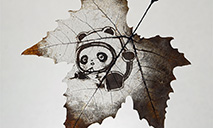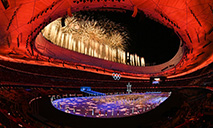Beijing 2022 Games’ poster weaves together Chinese aesthetics, Olympic spirit
A snowflake design made by intertwining a Chinese knot with the Olympic Rings can be seen on the poster Connecting the World by Enthusiasm, the official poster of the Beijing 2022 Olympic and Paralympic Winter Games. Unlike other posters made by professional designers, this minimalistic design that combines Chinese culture with the Olympic spirit was created by a student in Sichuan Province.
Art and the Olympics
The design team at China's Sichuan Fine Arts Institute first pitched their work for Beijing 2022 in September 2020, after the Beijing Winter Olympics Organizing Committee announced in Beijing that it was accepting submissions.
Including the main designer Zhang Sujun, a student at the school, and Yan Li, head mentor of the team who guided Zhang through the whole process, the special group has five members, each of whom has said designing a poster for Games in their home country is the experience of a lifetime.
"We did not care about whether or not we would be selected," Yan told the Global Times.
"Showing the cultural confidence of China" was the main theme they chose to underpin the whole project, but they were still left with the puzzle of how to make the design represent both China and the World.
"We wanted to use a design language that shows the uniqueness of Chinese aesthetics, but it had to be traditional and modern at the same time," said Yan.
"Traditional Chinese design can also be trendy."
After studying past Summer and Winter Olympic posters, the design team considered Chinese elements such as the characters "Beijing," the Great Wall and folk paper-cutting.
In the end, they pitched more than 10 designs to the Organizing Committee, whose final decision landed on the iconic Chinese knot.
"It was a big challenge to use the Chinese knot in the design as it has become a common design symbol, so designers have to get creative if they want to have it represent a message beyond just 'a symbol of China.'"
Atypical Chinese knot
The similarities between the way a Chinese knot is woven together and the interlocking nature of the Olympic Rings inspired the team to incorporate the five colored rings inside of a white Chinese knot against a pure red background in a prototype that was both elegant and eye-catching.
According to Yan, the weaving of the knot also symbolizes how the future of the world is bound together.
The Chinese knot is surrounded by eight arrows that transform the entire shape into a "snowflake," which emphasizes that Beijing, host of the 2008 Summer Games, became a double-Olympic city in the winter of 2022.
"The modern feel comes from details such as the rounder and sleek corners of how the knot has been drawn and also the new messages added to this intangible cultural heritage of China," Zhu Min, a veteran graphic designer, told the Global Times.
As one of China's intangible cultural heritage items, the Chinese knot is an intricate design that uses only one string to weave the whole pattern. Dating back to the Warring States period (475BC-221BC), it became a common part of Chinese folk art during the Qing Dynasty (1644-1911).
The one string artistry and also the carefully designed tassel of the Olympic Rings' colors tie the world, China and the city of Beijing together, Yan explained.
Zhang asked Yan for help when receiving the dozen of revision recommendations for the poster from the Organizing Committee.
The recommendations went into extreme details like the thickness of the tassel and the direction of the arrows.
Despite the difficulties involved, the team managed to make their work stand out from more than 1,500 submissions from teachers and students at hundreds of design institutions across the country. It was one of 11 official posters for the 2022 Games to display Chinese culture on the Olympic stage. "To be selected was a tremendous encouragement to us," said Yan.
"We hope our future design can continue to present the Chinese philosophy of 'being different but harmonious' and 'beauty in the common' to viewers around the world."
Photos
Related Stories
- Guo Yujie, Wang Zhidong to bear China's flag at Beijing Paralympics opening ceremony
- People living with disabilities in Beijing create woolen bouquets for Olympic and Paralympic Winter Games
- English skier Slegg chases Paralympic glory in Beijing
- Winter Paralympic torch relay starts in Beijing
- Highlights of Beijing 2022 Paralymic Torch Relay and Flame Lighting Ceremony
Copyright © 2022 People's Daily Online. All Rights Reserved.










